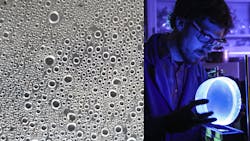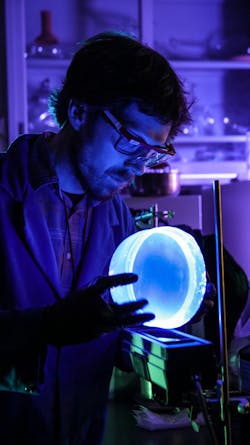To crack down on smugglers trying to sneak radioactive materials into the U.S., the Department of Homeland Security has long used relatively simple but effective radiation detectors in traffic lanes at ports of entry. They consist of two-inch thick sheets of polyvinyltoluene (PVT) which contain fluorescent molecules that glow when radiation hits them. Light collectors on the top of the sheets gather light from the glowing molecules and the amount of light they register reflects the amount of radiation that hit the sheet, giving guards an indication of whether the vehicle’s carrying radioactive materials.
“For reliable radiation measurements, it’s of the utmost importance that the plastic is optically transparent and remains that way for decades,” says Nick Myllenbeck, a materials scientist at Sandia National Laboratory. However, the plastic’s radiation detection started to degrade after a few years in the field. It looked like a fog of droplets was forming inside the sheets. They scattered light from the glowing molecules and prevented some of it from reaching the detectors, reducing the detector’s sensitivity.
To figure out how to prevent this fogging, Sandia researchers, working with colleagues at Lawrence Livermore, Pacific Northwest and Oak Ridge National Labs, first had to determine how the fog formed. They suspected it appeared in the PVT much like it does in air—by water condensing when the air temperature drops.
The researchers put samples of PVT in a humidity chamber and cycled the temperature from warm to cool to mimic daytime and nighttime temperatures. The samples absorbed only about 0.03% water by mass, but during cooling cycles, researchers saw the fog-like droplets appear in the samples.
When they examined the fogged PVT under a microscope, however, they realized the droplets were microscale defects in the plastic caused by condensed water absorbed from the air.
They eventually realized the defects formed in two phases. During the first few warm and cool cycles, the fog-like defects appear to be completely reversible upon heating or drying the plastic. However, if water remains in the plastic and the material goes enough temperature cycles, the defects grow and become permanent.
Once the researchers knew how the fog formed, they put various additives in the plastic to keep water from forming defects by having the water hydrogen bond to them.
Eventually, the researchers identified a commercially available additive that interacts with water and the plastic. When they tested the combination of PVT and additive under accelerated temperature and humidity conditions, the researchers saw no signs of fogging after tens of cycles. In contrast, the standard plastic would fog severely after just one cycle. Myllenbeck suspects that water inside the plastic clings to the additive rather than the other water molecules, preventing droplet formation and the light scattering defects.
The required fix fits well into existing manufacturing processes for the PVT sheets, so manufacturers have been able to scale up production rapidly to make large sheets to replace fogged detectors.
“This one ingredient change is a huge advantage to manufacturers,” he said. “They only have to add a small amount of this compound to their existing formula, with minor process modifications, to produce a nonfogging material that performs identically to the existing plastic.”

